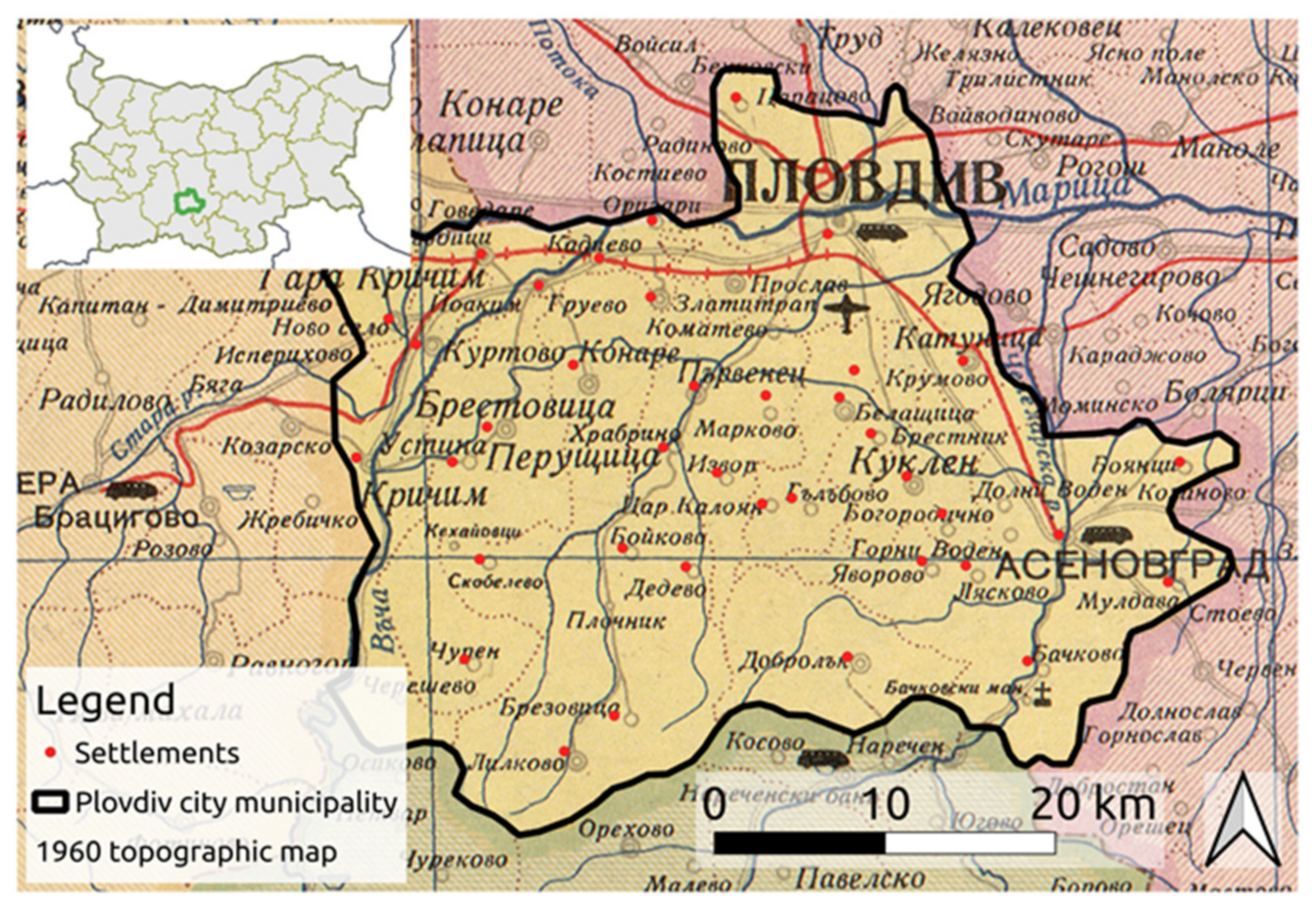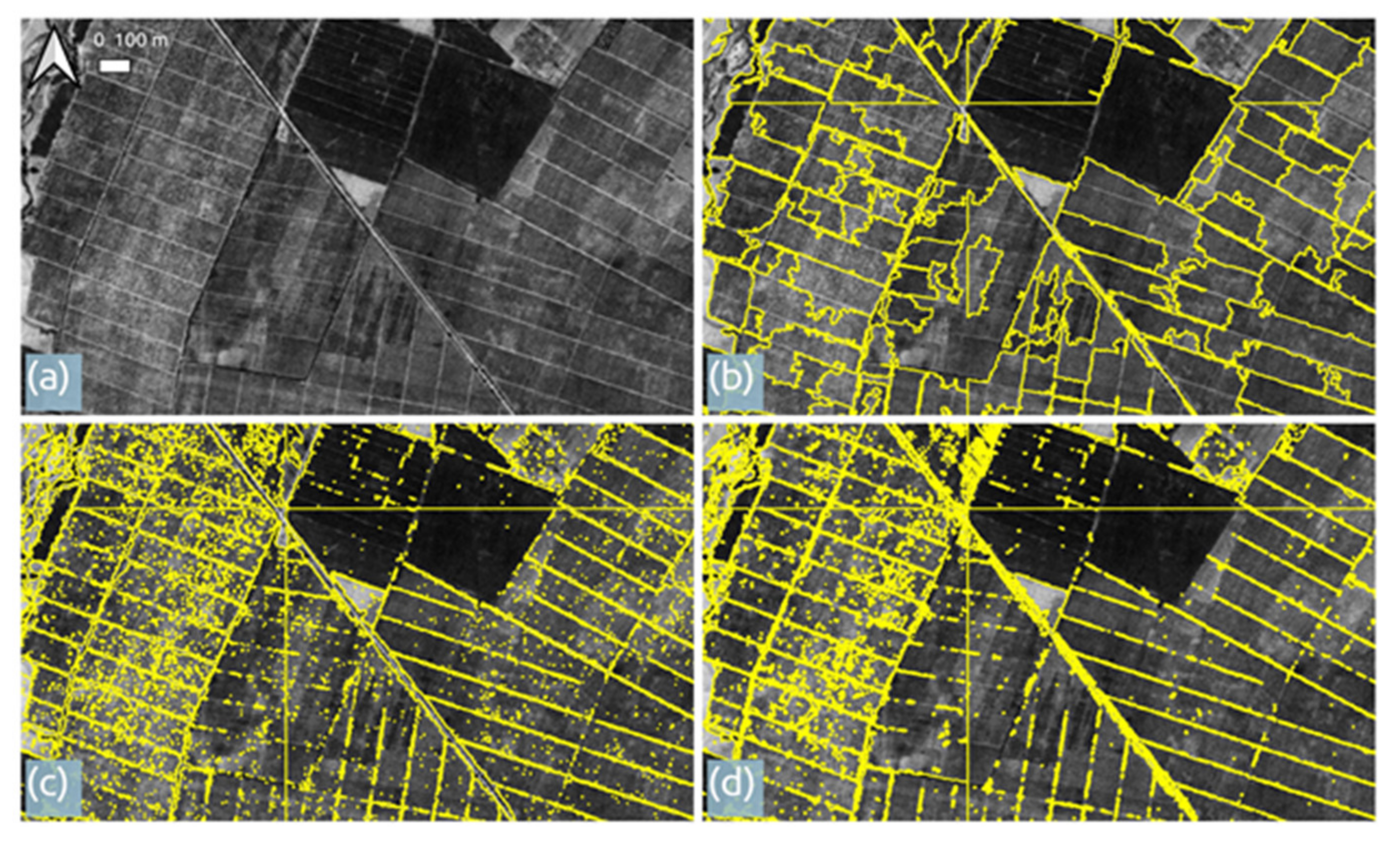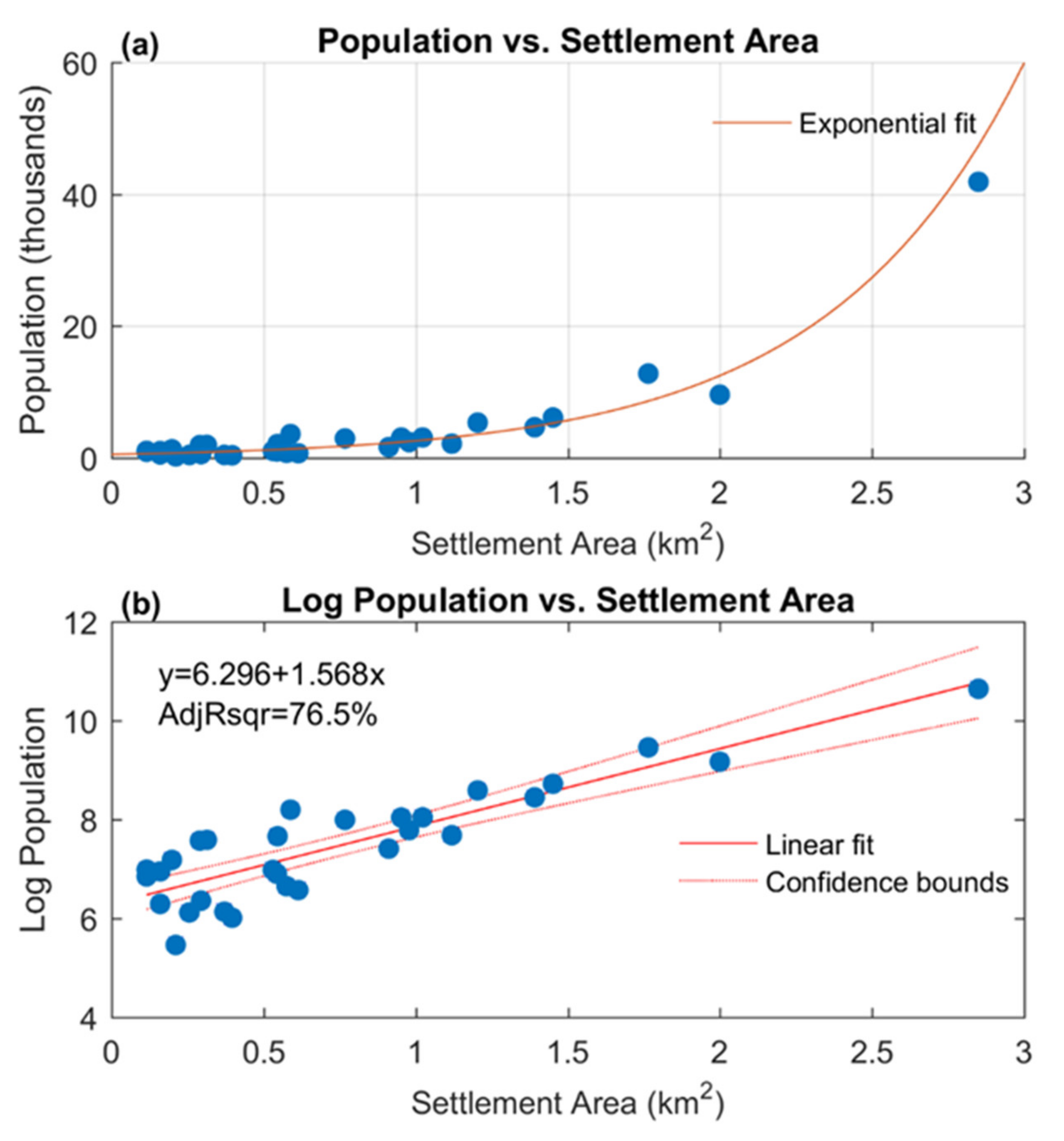Information Extraction and Population Estimates of Settlements from Historic Corona Satellite Imagery in the 1960s
Abstract
:1. Introduction
2. Materials and Methods
2.1. Study Area
2.2. Corona Satellite Imagery
2.3. Census
2.4. Methodology
3. Results
4. Discussion
5. Conclusions
Author Contributions
Funding
Institutional Review Board Statement
Informed Consent Statement
Data Availability Statement
Acknowledgments
Conflicts of Interest
References
- Earth Resources Observation and Science (EROS) Center. USGS EROS Archive—Declassified Data—Declassified Satellite Imagery—1. 2020. Available online: https://www.usgs.gov/centers/eros/science/usgs-eros-archive-declassified-data-declassified-satellite-imagery-1?qt-science_center_objects=0#qt-science_center_objects (accessed on 6 October 2020).
- McDonald, R.A. Opening the Cold War sky to the public-Declassifying satellite reconnaissance imagery. Photogramm. Eng. Remote Sens. 1995, 61, 385–390. [Google Scholar]
- Central Intelligence Agency. News & Information, CORONA: Declassified. 2020. Available online: https://www.cia.gov/news-information/featured-story-archive/2015-featured-story-archive/corona-declassified.html (accessed on 8 November 2020).
- Philip, G.; Donoghue, D.; Beck, A.; Galiatsatos, N. CORONA satellite photography: An archaeological application from the Middle East. Antiquity 2002, 76, 109–118. [Google Scholar] [CrossRef] [Green Version]
- Challis, K.; Priestnall, G.; Gardner, A.; Henderson, J.; O’Hara, S. Corona remotely-sensed imagery in dryland archaeology: The Islamic city of al-Raqqa, Syria. J. Field Archaeol. 2004, 29, 139–153. [Google Scholar] [CrossRef]
- Beck, A.; Philip, G.; Abdulkarim, M.; Donoghue, D. Evaluation of Corona and Ikonos high resolution satellite imagery for archaeological prospection in western Syria. Antiquity 2007, 81, 161–175. [Google Scholar] [CrossRef] [Green Version]
- Hritz, C. A malarial-ridden swamp: Using Google Earth Pro and Corona to access the southern Balikh valley, Syria. J. Archaeol. Sci. 2013, 40, 1975–1987. [Google Scholar] [CrossRef]
- Fowler, M.J.F. Cover: Declassified CORONA KH-4B satellite photography of remains from Rome’s desert frontier. Int. J. Remote Sens. 2004, 25, 3549–3554. [Google Scholar] [CrossRef]
- Ur, J. CORONA Satellite Photography and Ancient Road Networks: A Northern Mesopotamian Case Study. Antiquity 2003, 77, 102–115. [Google Scholar] [CrossRef] [Green Version]
- Hepcan, C.C. Quantifying landscape pattern and connectivity in a Mediterranean coastal settlement: The case of the Urla district, Turkey. Environ. Monit. Assess. 2013, 185, 143–155. [Google Scholar] [CrossRef] [PubMed]
- Sohn, H.G.; Kim, G.H.; Yun, K.H. Rigorous sensor modeling of early reconnaissance CORONA imagery for monitoring urban growth. In Proceedings of the 2003 IEEE International Geoscience and Remote Sensing Symposium, Toulouse, France, 21–25 July 2003; Volume 3, pp. 1929–1931. [Google Scholar]
- Andersen, G.L. How to detect desert trees using corona images: Discovering historical ecological data. J. Arid. Environ. 2006, 65, 491–511. [Google Scholar] [CrossRef] [Green Version]
- Awange, J.; Kiema, J. CORONA Historical De-classified Products. In Environmental Geoinformatics; Springer: Cham, Switzerland, 2019; pp. 191–199. [Google Scholar]
- Tappan, G.G.; Hadj, A.; Wood, E.C.; Lietzow, R.W. Use of Argon, Corona, and Landsat imagery to assess 30 years of land resource changes in west-central Senegal. Photogramm. Eng. Remote Sens. 2000, 66, 727–736. [Google Scholar]
- Tappan, G.; McGahuey, M. Tracking environmental dynamics and agricultural intensification in southern Mali. Agric. Syst. 2007, 94, 38–51. [Google Scholar] [CrossRef]
- Saleem, A.; Corner, R.; Awange, J. On the possibility of using CORONA and Landsat data for evaluating and mapping long-term LULC: Case study of Iraqi Kurdistan. Appl. Geogr. 2018, 90, 145–154. [Google Scholar] [CrossRef]
- Brinkmann, K.; Schumacher, J.; Dittrich, A.; Kadaore, I.; Buerkert, A. Analysis of landscape transformation processes in and around four West African cities over the last 50 years. Landsc. Urban Plan. 2012, 105, 94–105. [Google Scholar] [CrossRef]
- Ruelland, D.; Levavasseur, F.; Tribotté, A. Patterns and dynamics of land-cover changes since the 1960s over three experimental areas in Mali. Int. J. Appl. Earth Obs. Geoinf. 2010, 12, S11–S17. [Google Scholar] [CrossRef]
- Ruelland, D.; Tribotte, A.; Puech, C.; Dieulin, C. Comparison of methods for LUCC monitoring over 50 years from aerial photographs and satellite images in a Sahelian catchment. Int. J. Remote Sens. 2011, 32, 1747–1777. [Google Scholar] [CrossRef]
- Fowler, M.J. Declassified intelligence satellite photographs. In Archaeology from Historical Aerial and Satellite Archives; Springer: New York, NY, USA, 2013; pp. 47–66. [Google Scholar]
- Comer, D.C.; Harrower, M.J. Mapping Archaeological Landscapes from Space; Springer Science & Business Media: Berlin/Heidelberg, Germany, 2013; Volume 5. [Google Scholar]
- Tapete, D. Remote Sensing and Geosciences for Archaeology. Geoscience 2018, 8, 41. [Google Scholar] [CrossRef] [Green Version]
- Schmidt, M.; Goossens, R.; Menz, G. Processing techniques for CORONA satellite images in order to generate high-resolution digital elevation models (DEM). In Observing Our Environment from Space: New Solutions for a New Millennium; CRC Press: Boca Raton, FL, USA, 2001; pp. 191–196. [Google Scholar]
- Altmaier, A.; Kany, C. Digital surface model generation from CORONA satellite images. ISPRS J. Photogramm. Remote Sens. 2002, 56, 221–235. [Google Scholar] [CrossRef]
- Sohn, H.G.; Kim, G.H.; Yom, J.H. Mathematical modelling of historical reconnaissance CORONA KH-4B Imagery. Photogramm. Rec. 2004, 19, 51–66. [Google Scholar] [CrossRef]
- Casana, J.; Cothren, J. Stereo analysis, DEM extraction and orthorectification of CORONA satellite imagery: Archaeological applications from the Near East. Antiquity 2008, 82, 732–749. [Google Scholar] [CrossRef] [Green Version]
- Gheyle, W.; Trommelmans, R.; Bourgeois, J.; Goossens, R.; Bourgeois, I.; De Wulf, A.; Willems, T. Evaluating CORONA: A case study in the Altai Republic (South Siberia). Antiquity 2004, 78, 391–403. [Google Scholar] [CrossRef]
- Goossens, R.; De Wulf, A.; Bourgeois, J.; Gheyle, W.; Willems, T. Satellite imagery and archaeology: The example of CORONA in the Altai Mountains. J. Archaeol. Sci. 2006, 33, 745–755. [Google Scholar] [CrossRef]
- Galiatsatos, N.; Donoghue, D.N.; Philip, G. An evaluation of the stereoscopic capabilities of CORONA declassified spy satellite image data. In Proceedings of the 25th EARSeL Symposium, Workshop on 3D Remote Sensing, Porto, Portugal, 6–11 June 2005. [Google Scholar]
- Goerlich, F.; Bolch, T.; Mukherjee, K.; Pieczonka, T. Glacier Mass Loss during the 1960s and 1970s in the Ak-Shirak Range (Kyrgyzstan) from Multiple Stereoscopic Corona and Hexagon Imagery. Remote Sens. 2017, 9, 275. [Google Scholar] [CrossRef] [Green Version]
- Deroin, J.P.; Buslov, M.M. Geomorphic study of seismically active areas using remote sensing data. Case of the Gorny Altai (Siberia) affected by the 2003 Altai earthquake. Bull. Société Géologique Fr. 2017, 188, 1–15. [Google Scholar] [CrossRef]
- Agapiou, A.; Alexakis, D.D.; Sarris, A.; Hadjimitsis, D.G. Colour to Greyscale Pixels: Re-seeing Greyscale Archived Aerial Photographs and Declassified Satellite CORONA Images Based on Image Fusion Techniques. Archaeol. Prospect. 2016, 23, 231–241. [Google Scholar] [CrossRef]
- Lorenz, H. Integration of Corona and Landsat Thematic Mapper data for bedrock geological studies in the high Arctic. Int. J. Remote Sens. 2004, 25, 5143–5162. [Google Scholar] [CrossRef]
- Versaci, M.; Morabito, F.C.; Angiulli, G. Adaptive Image Contrast Enhancement by Computing Distances into a 4-Dimensional Fuzzy Unit Hypercube. IEEE Access 2017, 5, 26922–26931. [Google Scholar] [CrossRef]
- Veluchamy, M.; Subramani, B. Fuzzy dissimilarity color histogram equalization for contrast enhancement and color correction. Appl. Soft Comput. 2020, 89, 106077. [Google Scholar] [CrossRef]
- De Laet, V.; Paulissen, E.; Meuleman, K.; Waelkens, M. Effects of image characteristics on the identification and extraction of archaeological features from Ikonos-2 and Quickbird-2 imagery: Case study Sagalassos (southwest Turkey). Int. J. Remote Sens. 2009, 30, 5655–5668. [Google Scholar] [CrossRef]
- Fowler, M.J.F. Modelling the acquisition times of CORONA satellite photographs: Accuracy and application. Int. J. Remote Sens. 2011, 32, 8865–8879. [Google Scholar] [CrossRef]
- Lu, D.; Weng, Q. A survey of image classification methods and techniques for improving classification performance. Int. J. Remote Sens. 2007, 28, 823–870. [Google Scholar] [CrossRef]
- Alonso, M.C.; Sanz, M.A.; Malpica, J.A. Classification of high resolution satellite images using texture from the panchromatic band. In International Symposium on Visual Computing; Springer: Berlin/Heidelberg, Germany, 2007; pp. 499–508. [Google Scholar]
- Grekousis, G. Spatial Analysis Methods and Practice: Describe–Explore–Explain through GIS; Cambridge University Press: Cambridge, UK, 2020. [Google Scholar]
- Todorova, M.N. Balkan Family Structure and the European Pattern: Demographic Developments in Ottoman Bulgaria; Central European University Press: Budapest, Hungary, 2006; Volume 3. [Google Scholar]
- Mladenov, C. Population Distribution in Bulgaria—Discussion Papers (Special). In Regional Challenges of the Transition in Bulgaria and Hungary; Centre for Regional Studies: Pécs, Hungary, 2002; pp. 20–26. [Google Scholar]
- Mladenov, C. Demographic Potential and Problems of the Settlements Network in the Mountains of Bulgaria. In Sustainable Development in Mountain Regions; Springer: Dordrecht, The Netherlands, 2011; pp. 159–171. [Google Scholar]
- Rangelova, R. Bio-demographic change and socio-economic trends in Bulgaria. Econ. Hum. Biol. 2003, 1, 413–428. [Google Scholar] [CrossRef] [PubMed]
- Mladenov, C.; Dimitrov, E.; Kazakov, B. Demographical development of Bulgaria during the transitional period. Méditerr. Rev. Géogr. Pays Méditerr. J. Mediterr. Geogr. 2008, 110, 117–123. [Google Scholar] [CrossRef]
- Čipin, I.; Ilieva, N. Coping with Demographic Decline in Croatia and Bulgaria; Friedrich Ebert Stiftung-Croatia: Zagreb, Croatia, 2017. [Google Scholar]
- UN Department of Economic and Social Affairs, Population Division. World Population Prospects 2019 Highlights, United Nations; UN Department of Economic and Social Affairs, Population Division: New York, NY, USA, 2019.
- Kabadayı, M.E.; Gerrits, P.; Boykov, G. Bridging the Gap between Pre-census and Census-era Historical Data: Devising a Geo-sampling Model to Analyse Agricultural Production in the Long Run for Southeast Europe, 1840–1897. Int. J. Arts Humanit. Comput. J. Digit. Humanit. 2020, 14, 46–63. [Google Scholar] [CrossRef]
- NASA. 2020. Available online: https://nssdc.gsfc.nasa.gov/nmc/spacecraft/display.action?id=1968-065A (accessed on 29 January 2020).
- DeRoin, J.P.; Téreygeol, F.; Cruz, P.; Guillot, I.; Méaudre, J.C. Integrated non-invasive remote-sensing techniques and field survey for the geoarchaeological study of the Sud Lípez mining district, Bolivia. J. Geophys. Eng. 2012, 9, S40–S52. [Google Scholar] [CrossRef]
- Bettencourt, L.M. The Origins of Scaling in Cities. Science 2013, 340, 1438–1441. [Google Scholar] [CrossRef] [PubMed] [Green Version]
- Ortman, S.G.; Cabaniss, A.H.; Sturm, J.O.; Bettencourt, L.M. The Pre-History of Urban Scaling. PLoS ONE 2014, 9, e87902. [Google Scholar] [CrossRef]
- Cebrat, K.; Sobczyński, M. Scaling Laws in City Growth: Setting Limitations with Self-Organizing Maps. PLoS ONE 2016, 11, e0168753. [Google Scholar] [CrossRef]
- Razak, M.I.M.; Omar, R.; Ismail, M.; Hamzah, A.S.; Hashim, M.A. Overview of Zakat Collection in Malaysia; Regional Analysis. Am. Int. J. Contemp. Res. 2013, 3, 140–148. [Google Scholar]
- QGIS Development Team. QGIS Geographic Information System. Open Source Geospatial Foundation Project. 2020. Available online: http://qgis.osgeo.org (accessed on 23 March 2021).
- Grizonnet, M.; Michel, J.; Poughon, V.; Inglada, J.; Savinaud, M.; Cresson, R. Orfeo ToolBox: Open source processing of remote sensing images. Open Geospat. Data Softw. Stand. 2017, 2, 1–8. [Google Scholar] [CrossRef] [Green Version]
- MATLAB; Version R2016b; The MathWorks Inc.: Natick, MA, USA, 2016.
- Stratoulias, D.; Kabadayi, M.E. Land Cover Feature Extraction from Corona Spy Satellite Images during the Cold WAR-1968. In Proceedings of the IGARSS 2020—2020 IEEE International Geoscience and Remote Sensing Symposium, Waikoloa, HI, USA, 19–24 July 2020; pp. 6069–6072. [Google Scholar]
- Duveiller, G.; Defourny, P. A conceptual framework to define the spatial resolution requirements for agricultural monitoring using remote sensing. Remote Sens. Environ. 2010, 114, 2637–2650. [Google Scholar] [CrossRef]
- McCarty, J.L.; Neigh, C.S.R.; Carroll, M.L.; Wooten, M.R. Extracting smallholder cropped area in Tigray, Ethiopia with wall-to-wall sub-meter WorldView and moderate resolution Landsat 8 imagery. Remote Sens. Environ. 2017, 202, 142–151. [Google Scholar] [CrossRef]
- Pax-Lenney, M.; Woodcock, C.E. The effect of spatial resolution on the ability to monitor the status of agricultural lands. Remote Sens. Environ. 1997, 61, 210–220. [Google Scholar] [CrossRef]
- Stratoulias, D.; De By, R.A.; Zurita-Milla, R.; Bijker, W.; Tolpekin, V.; Schulthess, U.; Ahmed, Z.U. The potential of very high spatial resolution remote sensing in applications in smallholder agriculture. In Proceedings of the 36th Asian Conference on Remote Sensing, ACRS 2015: Fostering Resilient Growth in Asia, Manila, Philippines, 19–23 October 2015. [Google Scholar]
- Gong, P.; Marceau, D.J.; Howarth, P.J. A comparison of spatial feature extraction algorithms for land-use classification with SPOT HRV data. Remote Sens. Environ. 1992, 40, 137–151. [Google Scholar] [CrossRef]
- Welch, R. Spatial resolution requirements for urban studies. Int. J. Remote Sens. 1982, 3, 139–146. [Google Scholar] [CrossRef]
- Herold, M.; Gardner, M.; Roberts, D. Spectral resolution requirements for mapping urban areas. IEEE Trans. Geosci. Remote Sens. 2003, 41, 1907–1919. [Google Scholar] [CrossRef] [Green Version]
- Stratoulias, D.; Tolpekin, V.; De By, R.A.; Zurita-Milla, R.; Retsios, V.; Bijker, W.; Hasan, M.A.; Vermote, E. A Workflow for Automated Satellite Image Processing: From Raw VHSR Data to Object-Based Spectral Information for Smallholder Agriculture. Remote Sens. 2017, 9, 1048. [Google Scholar] [CrossRef] [PubMed] [Green Version]
- Stratoulias, D.; Balzter, H.; Sykioti, O.; Zlinszky, A.; Tóth, V.R. Evaluating Sentinel-2 for Lakeshore Habitat Mapping Based on Airborne Hyperspectral Data. Sensors 2015, 15, 22956–22969. [Google Scholar] [CrossRef] [PubMed] [Green Version]
- Rao, P.V.N.; Sai, M.V.R.S.; Sreenivas, K.; Rao, M.V.K.; Rao, B.R.M.; Dwivedi, R.S.; Venkataratnam, L. Textural analysis of IRS-1D panchromatic data for land cover classification. Int. J. Remote Sens. 2002, 23, 3327–3345. [Google Scholar] [CrossRef]
- Pacifici, F.; Chini, M.; Emery, W.J. A neural network approach using multi-scale textural metrics from very high-resolution panchromatic imagery for urban land-use classification. Remote Sens. Environ. 2009, 113, 1276–1292. [Google Scholar] [CrossRef]
- Checchi, F.; Stewart, B.T.; Palmer, J.J.; Grundy, C. Validity and feasibility of a satellite imagery-based method for rapid estimation of displaced populations. Int. J. Health Geogr. 2013, 12, 4. [Google Scholar] [CrossRef] [PubMed] [Green Version]
- Hillson, R.; Coates, A.; Alejandre, J.D.; Jacobsen, K.H.; Ansumana, R.; Bockarie, A.S.; Bangura, U.; Lamin, J.M.; Stenger, D.A. Estimating the size of urban populations using Landsat images: A case study of Bo, Sierra Leone, West Africa. Int. J. Health Geogr. 2019, 18, 1–24. [Google Scholar] [CrossRef] [PubMed] [Green Version]
- Nash, S.; Tittle, V.; Abaasa, A.; Sanya, R.E.; Asiki, G.; Hansen, C.H.; Grosskurth, H.; Kapiga, S.; Grundy, C. The validity of an area-based method to estimate the size of hard-to-reach populations using satellite images: The example of fishing populations of Lake Victoria. Emerg. Themes Epidemiol. 2018, 15, 1–10. [Google Scholar] [CrossRef] [PubMed]
- Grekousis, G.; Mountrakis, G.; Kavouras, M. An overview of 21 global and 43 regional land-cover mapping products. Int. J. Remote Sens. 2015, 36, 5309–5335. [Google Scholar] [CrossRef]
- Grekousis, G.; Mountrakis, G.; Kavouras, M. Linking MODIS-derived forest and cropland land cover 2011 estimations to socioeconomic and environmental indicators for the European Union’s 28 countries. GISci. Remote Sens. 2015, 53, 122–146. [Google Scholar] [CrossRef]
- Stratoulias, D.; Kabadayı, M.E. Feature and information extraction for regions of Southeast Europe from Corona satellite images acquired in 1968. In Proceedings of the Eighth International Conference on Remote Sensing and Geoinformation of the Environment (RSCy2020), Paphos, Cyprus, 16–18 March 2020; International Society for Optics and Photonics: Washington, DC, USA, 2020; Volume 11524, p. 115241R. [Google Scholar]
- Keramitsoglou, I.; Stratoulias, D.; Fitoka, E.; Kontoes, C.; Sifakis, N. A transferability study of the kernel-based reclassification algorithm for habitat delineation. Int. J. Appl. Earth Obs. Geoinform. 2015, 37, 38–47. [Google Scholar] [CrossRef]
- Blaschke, T. Object based image analysis for remote sensing. ISPRS J. Photogramm. Remote Sens. 2010, 65, 2–16. [Google Scholar] [CrossRef] [Green Version]








| Attribute | Corona-Camera KH-4B |
|---|---|
| Image ID | DS1104-2155DF040, DS1104-2155DF041, DS1104-2155DF042, DS1104-2155DF043 |
| Photogrammetric scanning resolution | 7 Micron (3600 dpi) |
| Dynamic range | 11 bit |
| Spatial resolution (georegistered) | 2.75 m |
| Number of bands | 1 (panchromatic) |
| Spectral bandwidth | 500–900 nm |
| Attribute | Value (m) |
|---|---|
| MeanX of absolute residual values | 5.288 |
| Standard deviationX of absolute residual values | 4.026 |
| MeanY of absolute residual values | 1.875 |
| Standard deviationY of absolute residual values | 0.205 |
| MinX residual | −0.136 |
| MaxX residual | 17.1 |
| MinY residual | 1.416 |
| MaxY residual | 2.318 |
| RMSEX | 6.616 |
| RMSEY | 1.886 |
| Power Model | Exponential Model | |
|---|---|---|
| R-squared | 0.610 | 0.773 |
| Adjusted R-Squared | 0.596 | 0.765 |
| Root Mean Square Error (RMSE) | 0.725 | 0.552 |
| F-statistic p-value | 3.5 × 10−7 | 1.58 × 10−10 |
Publisher’s Note: MDPI stays neutral with regard to jurisdictional claims in published maps and institutional affiliations. |
© 2021 by the authors. Licensee MDPI, Basel, Switzerland. This article is an open access article distributed under the terms and conditions of the Creative Commons Attribution (CC BY) license (https://creativecommons.org/licenses/by/4.0/).
Share and Cite
Stratoulias, D.; Grekousis, G. Information Extraction and Population Estimates of Settlements from Historic Corona Satellite Imagery in the 1960s. Sensors 2021, 21, 2423. https://doi.org/10.3390/s21072423
Stratoulias D, Grekousis G. Information Extraction and Population Estimates of Settlements from Historic Corona Satellite Imagery in the 1960s. Sensors. 2021; 21(7):2423. https://doi.org/10.3390/s21072423
Chicago/Turabian StyleStratoulias, Dimitris, and George Grekousis. 2021. "Information Extraction and Population Estimates of Settlements from Historic Corona Satellite Imagery in the 1960s" Sensors 21, no. 7: 2423. https://doi.org/10.3390/s21072423
APA StyleStratoulias, D., & Grekousis, G. (2021). Information Extraction and Population Estimates of Settlements from Historic Corona Satellite Imagery in the 1960s. Sensors, 21(7), 2423. https://doi.org/10.3390/s21072423







